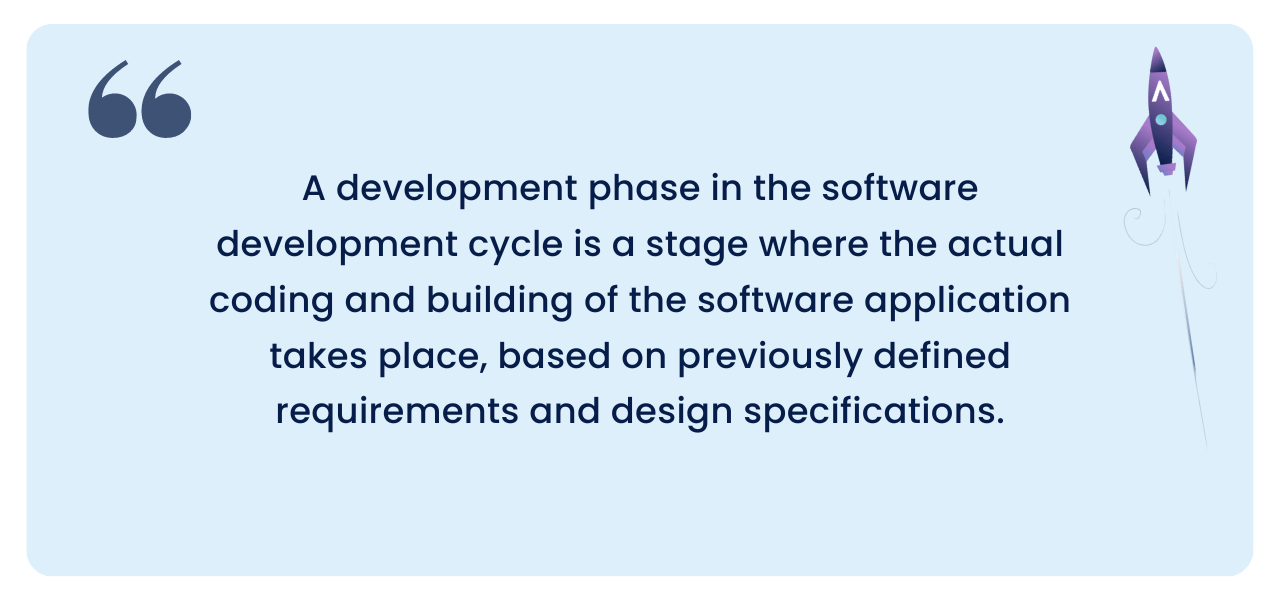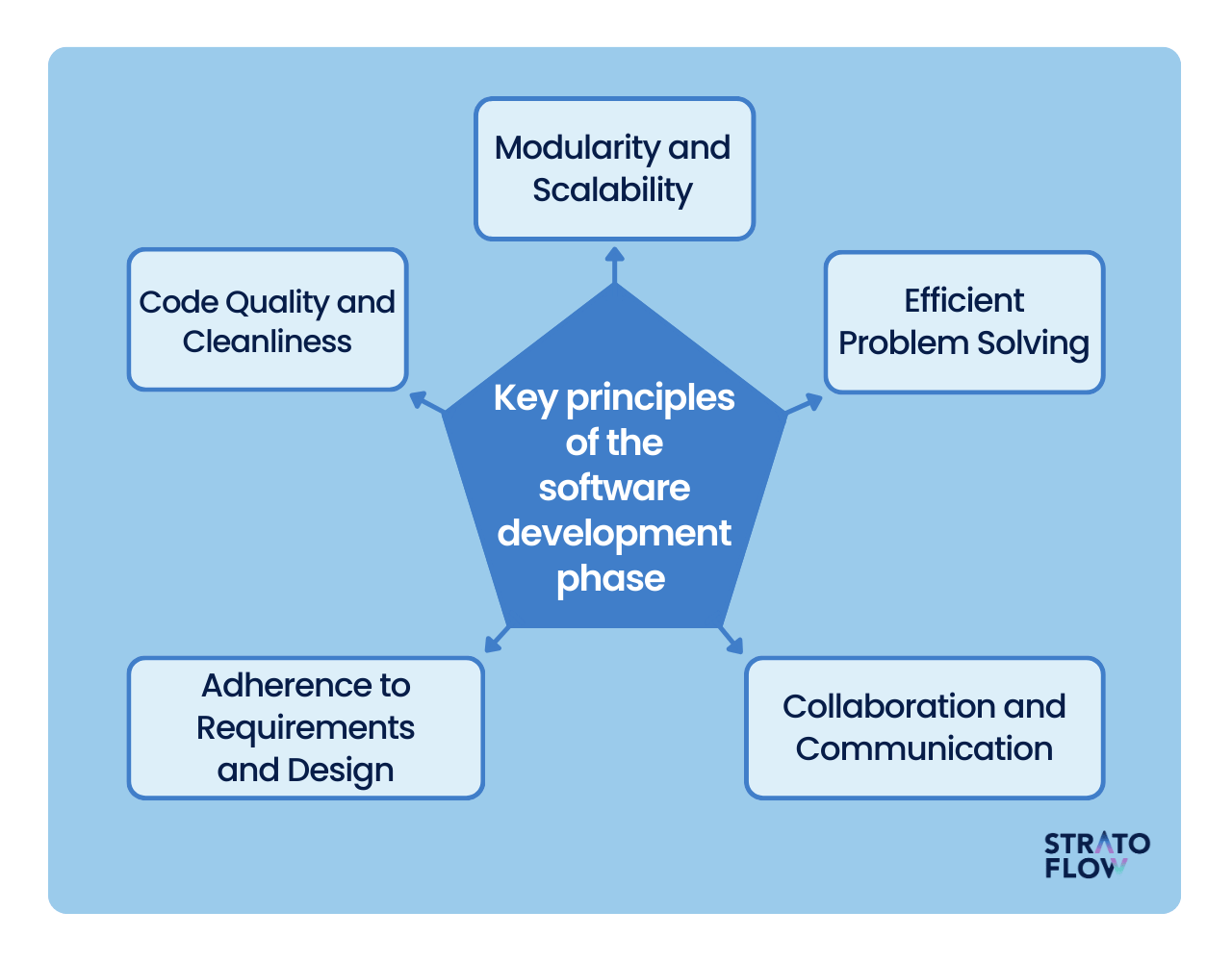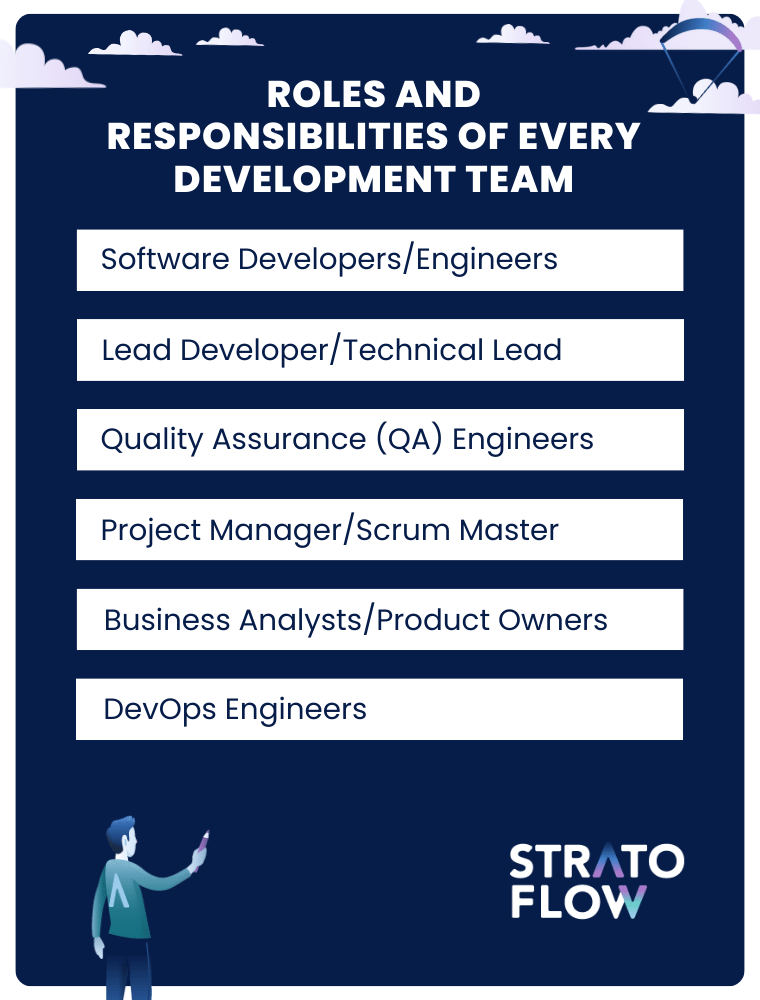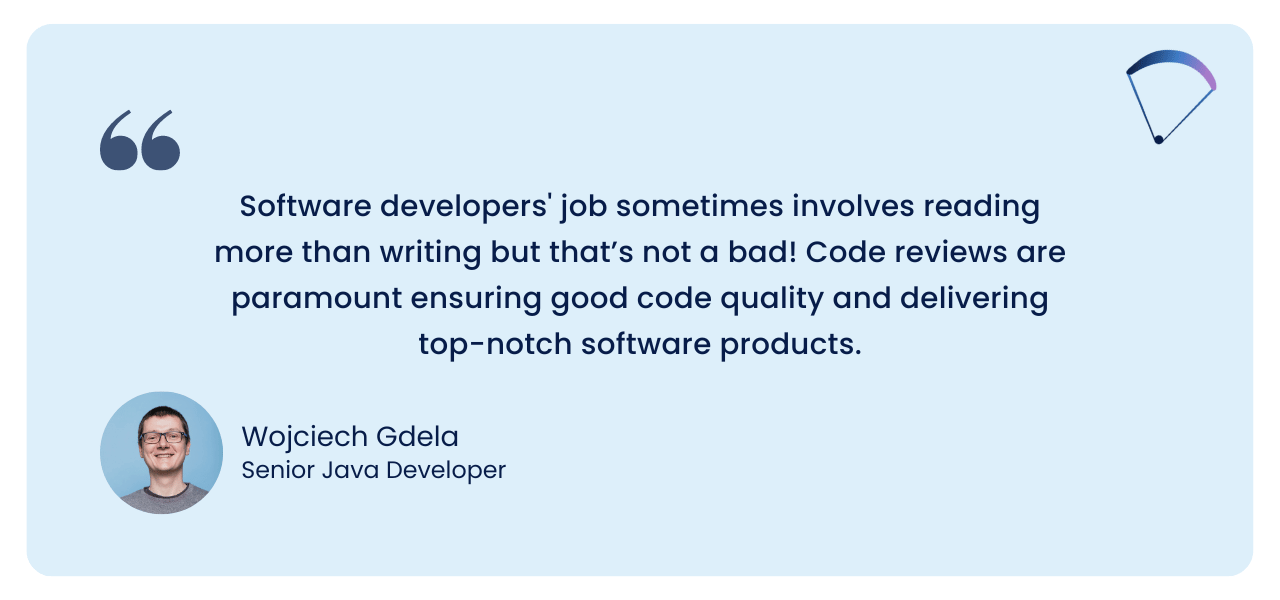
SDLC Guide: Coding and Development Phase in Software Engineering
Welcome back to our ongoing series on the Software Development Life Cycle (SDLC). In this latest installment, we focus on the crucial coding and development phase, a stage where the real magic of software engineering comes to life.
We’ll explore the essential steps and best practices that turn abstract concepts and designs into tangible, working software.
Whether you’re a budding programmer or a business strategist, this article is designed to shed light on the complexities and nuances of this phase and equip you with the knowledge to navigate it successfully.
Contents
- What is the development phase in the software development life cycle?
- How does a development phase look like?
- Key principles of the software development phase in SDLC
- Roles and responsibilities of every development team
- Key tips for smooth development phase
- Next phase of system development life cycle: implementation phase
What is the development phase in the software development life cycle?
The development phase in the software development life cycle is the phase in which the actual creation of the software takes place. It involves programmers and developers writing code and building the software according to the requirements and design specifications outlined in the design phase and requirements analysis phase.
Imagine you’re building a house; this phase is where the actual structure is put together, brick by brick.

In software terms, this is where the real coding happens.
Developers take all the plans and designs made in earlier phases and start writing the code to make the software work.
It’s a critical step because this is where the final software product begins to take shape, leaving the prototyping and minimum viable product phase and turning ideas and designs into working software. The success of this phase is critical to the project because it lays the foundation for how well the software will work.
How does a development phase look like?
In the development phase of a custom software development project, the workflow is detailed and methodical. Once the software development planning stage and design phase are complete, developers begin the core task of writing code. Here’s a closer look at what makes up the development phase:
- Coding: Developers write the actual code for the software, creating its features and functionality.
- Integration: Different parts of the software, often developed separately, are combined to work together as a whole.
- Component Testing phase: Each part of the software is tested individually to ensure it works correctly.
- Review and Revision: The code is regularly checked and corrected to improve quality and fix any errors.
- Version Control: Systems are used to manage changes in the code, helping to organize and track different versions.
- Documentation: Developers write documents and comments within the code to explain how it works, aiding future maintenance and updates.
The code that is being developed during the development stage is based on the software’s requirements and design documents and ensures that all planned features and functionality are implemented.
As developers write code, they often integrate different components. These components can be different modules or features of the software, and integration is critical to ensuring that they work together seamlessly.
During the development phase, component testing is an ongoing activity. Developers test each part of the software as it’s developed to catch and fix bugs early. This testing is often done through unit tests, which are automated tests that check small pieces of code for correctness.
As development progresses, code reviews become essential.
Teammates review each other’s code for quality, and adherence to standards, and to identify potential problems. This practice helps maintain code quality and consistency throughout the project.
Version control systems play a critical role in this phase. They help track changes, manage different versions of the software, and facilitate collaboration among team members. These systems are especially important in projects where multiple developers are working on different parts of the software at the same time.
Finally, documentation is an ongoing task and its importance cannot be disregarded.
This documentation is essential for future maintenance, updates, and for new team members who may join the project at a later stage.
Overall, the development phase of custom software projects is a mix of intensive coding, constant testing, regular reviews, and meticulous documentation, all aimed at creating a functional and robust software product.
[Read also: Off the Shelf vs Custom Software: Pros & Cons + Examples]
Key principles of the software development phase in SDLC
The development phase of the software development process is guided by several key principles, each of which plays a critical role in ensuring the creation of a successful and efficient software product. Here are five key principles:

Code Quality and Cleanliness
High-quality, clean code is fundamental. This means writing code that is not only functional but also readable, maintainable and well-documented. It involves adhering to coding standards, using meaningful names for variables and functions, and organizing the code logically.
Modularity and Scalability
The code should be modular, meaning it’s divided into separate, smaller parts (modules) that can be independently developed, tested, and maintained. This approach enhances cloud scalability, allowing the software to be easily expanded or modified as requirements evolve.
Efficient Problem Solving
The ability to effectively tackle and solve problems is essential. This includes debugging skills, the ability to think logically and algorithmically, and the creativity to find innovative solutions to complex challenges.
Collaboration and Communication
Effective teamwork and clear communication are vital. Software development is typically a collaborative effort, requiring developers to work closely with each other, as well as with other stakeholders like project managers, quality assurance teams, and clients.
Adherence to Requirements and Design
Development should be closely aligned with predefined requirements and design specifications. This ensures that the software meets the needs and expectations of users and stakeholders and performs as intended in the real-world environment.
Together, these principles ensure that the software developed is not only technically sound, but also well aligned with user needs and business goals, setting the stage for successful implementation stage and deployment and maintenance stage.
[Read also: Benefits of Open-Source Software for Developers, Managers and Business]
Roles and responsibilities of every development team
In the dynamic world of software development, each member of the development team plays an important role and brings unique skills and expertise to the project.
Understanding the roles and responsibilities of each team member is critical to the smooth execution and success of any software project.
Let’s explore the specific functions and contributions of each role within the development team and how they work together to turn software concepts into reality.

Software Developers/Engineers

Responsibilities
- Writing and implementing code based on the project’s requirements and design.
- Integrating different software components and libraries.
- Conducting basic testing (unit tests) to ensure that individual components work correctly.
- Documenting their code for future reference and for other team members.
- Participating in code reviews and modifying code as necessary.
Qualities
Developers should have excellent coding skills, with knowledge of relevant programming languages and technologies.
They must be adept at writing clean, efficient, and maintainable code. Critical thinking and problem-solving skills are paramount, as they often need to come up with creative solutions to technical challenges. Attention to detail is essential for finding and fixing bugs. Developers must also be able to understand and interpret complex software designs.
In addition, collaboration skills are essential as they often work in teams and need to communicate effectively with other team members.
Lead Developer/Technical Lead

Responsibilities
- Overseeing the technical aspects of the project.
- Guiding the development team and ensuring adherence to coding standards and best practices.
- Reviewing code and providing feedback.
- Managing integration of different software components.
- Solving complex technical problems and making decisions that affect the overall architecture and design.
Qualities
A technical lead above all else should have deep technical knowledge and experience.
They must be knowledgeable about software design patterns, architectures, and coding best practices. Leadership and team management skills are critical as they guide and mentor junior developers. They should have excellent decision-making skills, able to evaluate multiple options, and choose the best path forward. Strong problem-solving skills are also essential.
Just like in the case of regular developers communication skills are also important for articulating technical concepts to both technical and non-technical stakeholders.
Quality Assurance (QA) Engineers

Responsibilities
- Working closely with developers to understand the functionality and scope of software components.
- Creating and executing detailed testing plans to identify bugs and issues.
- Documenting and reporting bugs and issues to the development team.
- Ensuring that the software meets all quality standards and requirements before it moves to the next phase.
Qualities
First and foremost QA Engineers must be meticulous and detail-oriented, with a focus on finding and fixing defects in the software project.
They need a good understanding of software testing methodologies and tools. Analytical skills are essential to break down complex software systems and understand where problems might occur. You should have a good understanding of both technical details and user requirements to ensure that the software meets all specifications.
As with the previous positions, communication skills are essential for reporting bugs and explaining their impact. They should also be patient and persistent, as thorough testing can be a time-consuming and repetitive process.
Project Manager/Scrum Master

Responsibilities
- Coordinating between different team members and ensuring that the development phase is on track.
- Managing timelines, resources, and project scope and business objectives.
- Facilitating communication and collaboration within the team.
- Addressing any logistical or resource-related challenges.
- Ensuring adherence to the project’s software development methodology (e.g., Agile model, Scrum).
Qualities
Project Managers should be highly organized and knowledgeable about software development methodologies (usually Agile, since it’s the most popular and important).
They need excellent leadership skills to guide and motivate their team.
Strong communication and interpersonal skills are especially important for facilitating discussions, managing expectations, and resolving conflicts. You should be adept at problem-solving and decision-making to overcome project challenges. Time management and resource allocation skills are also important.
They must be flexible and adaptable, able to adjust project plans as requirements change.
Business Analysts/Product Owners

Responsibilities
- Providing clarity on business requirements and user needs.
- Ensuring that the development aligns with business goals and user expectations.
- Prioritizing features and tasks based on business value.
- Providing feedback on the product during development from a user’s perspective.
Qualities
Business analysts should have a deep understanding of business processes and market dynamics.
They need excellent analytical skills to dissect complex requirements and translate them into actionable project goals. Strong communication skills are essential for liaising between stakeholders and the development team.
You should be good at problem-solving and decision-making, prioritizing tasks based on business value. Negotiation skills are also important, as they often need to reconcile differing viewpoints and requirements.
DevOps Engineers

Responsibilities
- Setting up and maintaining the development and testing environments.
- Ensuring smooth deployment and integration processes.
- Managing version control systems and assisting with release management.
- Automating development and deployment processes to improve efficiency.
Qualities
DevOps engineers should have a strong foundation in both software development and system operations.
They need knowledge of automation tools, cloud services, and scripting languages. Problem-solving skills are essential, as they often need to find efficient ways to automate and improve development and deployment processes.
They should be proactive, constantly looking for ways to optimize performance and reliability. Good communication skills are required to work with development and operations teams.
Key tips for smooth development phase
In the quest for a smoother and more efficient software development phase, certain strategies and practices stand out for their effectiveness.
Below, we delve into practical tips from our most seasoned software developers that can significantly streamline the development process, enhancing both productivity and the quality of the final product.
These insights are designed to guide developers and teams toward a more optimized and seamless development:

Embrace Refactoring Regularly
Don’t consider your initial code final.
What do I mean by that?
As you probably know refactoring is about redesigning and improving the internal structure of code while maintaining its external functionality. It’s a disciplined approach to cleaning up code, improving its readability, and ensuring that it adheres to best practices.
Developers often associate refactoring with software application modernization efforts and working with legacy software systems.
This is a mistake.
Regularly reviewing and refactoring code can greatly improve its efficiency and readability.
When you refactor regularly, you turn the coding process into a proactive exercise in continuous improvement. It’s like tending a garden; constant care and attention leads to robust growth and health. Refactoring helps identify redundant code, simplify complex segments, and eliminate inefficiencies. While this process is time-consuming, it pays off in the long run by preventing the code base from becoming outdated or overly complex.
Invest in Understanding the Domain
A deep understanding of the problem domain can be just as important as technical skills.
Take the time to learn about the domain or industry you’re developing software for. This knowledge will help you anticipate needs, identify potential problems, and create more effective, user-centered solutions.
In industries like travel, e-commerce, or fintech, where regulations, financial instruments, and market dynamics are complex and constantly evolving, having a firm grasp on the domain can make a significant difference. Developers who understand the intricacies of the financial world can design and implement solutions that are not only technically sound, but also closely aligned with business objectives and regulatory requirements.
This domain knowledge allows for a more nuanced approach to problem-solving, resulting in software that effectively addresses the unique challenges and needs of the industry.
Master the Art of Reading Code
Writing code is just one part of the job; reading and understanding existing code is equally important.
Some programmers say that the profession of a software developer is more about reading than writing because of the amount of time we spend on code reviews and reading someone else’s job.

But there’s a reason for that.
This skill is invaluable, especially when it comes to code reviews, a fundamental process in the development cycle that ensures code quality and promotes best practices such as clean code.
Code reviews aren’t just about catching bugs; they’re an opportunity for collective learning and maintaining a high standard of code quality. They provide a platform for developers to review each other’s code for clarity, efficiency, maintainability, and adherence to clean code principles.
During code reviews, developers should focus on these aspects, assessing whether the code is well structured, well documented, and follows established coding standards and practices.
An essential part of mastering the art of code reading is developing a positive attitude toward the feedback received during code reviews. Developers should not take criticism personally or become defensive when a colleague points out areas for improvement. Instead, they should welcome such feedback as a valuable opportunity for growth and learning.
Prioritize Automated Testing
Get into the habit of writing automated tests along with your code.
In software development, automated testing isn’t just a phase to be checked off; it’s an essential practice that ensures the reliability and quality of your software.
Automated testing involves writing scripts and using tools to automatically check your code for errors and ensure that it behaves as expected.
This approach to testing has several advantages over manual testing. It’s more efficient, because tests can be run quickly and repeatedly without additional effort. It’s also more consistent, reducing the risk of human error in repetitive testing scenarios.
The importance of testing in software development cannot be overstated. It’s the safeguard against bugs and errors that, if missed, can lead to significant problems down the road, including poor user experience, system failures, and security vulnerabilities. By prioritizing automated testing, developers can catch problems early in the development cycle, making them easier and less costly to fix.
Incorporating automated testing from the start encourages developers to write more modular, testable code, resulting in better software design.
Seek Feedback, Even When It’s Tough
Seek regular feedback on your code, not only from automated tools, but also from your peers.
Constructive criticism can be invaluable for growth. Be open to suggestions and willing to adjust your approach. This practice fosters a collaborative environment and leads to collective improvements in code quality.
Software development is an inherently evolving and learning field. Technologies, practices, and standards are constantly changing, making adaptability and a willingness to learn essential qualities for any developer.
A key component of this learning process is seeking and accepting feedback, particularly during code reviews. Code reviews serve not only as a quality assurance tool, but also as a platform for knowledge sharing and collective improvement.
The best developers understand that everyone has something to learn, no matter how experienced, and that constructive feedback is a valuable resource for improving their skills.
Developers should actively seek feedback from a variety of sources – be they peers, mentors, or even online communities. Every piece of advice, every different perspective, has the potential to add to their repertoire of skills and knowledge.
Adopt a ‘Less is More’ Philosophy
Strive for simplicity in your code.
This principle goes beyond just writing code; it’s about embracing minimalism and efficiency in software development.
In the complex world of software development, it’s easy to fall into the trap of overengineering solutions – adding more features, layers, or complexity than necessary.
The “less is more” philosophy, however, advocates the opposite.
It encourages developers to strive for simplicity in their code. Simple code isn’t just about fewer lines of code; it’s about creating solutions that are straightforward, easy to understand, and efficient in achieving their purpose. This approach minimizes the risk of errors, makes the software easier to maintain and update, and improves its overall readability.
Adopting this philosophy requires developers to constantly evaluate their solutions, asking questions such as “Is there a simpler way to do this?” or “Are all these components necessary?
It’s about focusing on the essentials and cutting out the extraneous. This minimalist approach often leads to more elegant and innovative solutions because it forces developers to think more critically and creatively.
Next phase of system development life cycle: implementation phase
Following the development phase in the software development process, the next crucial stages are “implementation” and “deployment and maintenance.”

In the implementation phase, the now fully developed software is put into operation. This stage is like moving from theory to practice.
It involves installing the software in its intended environment, configuring it according to the user’s needs, and making sure it integrates well with other systems or software it needs to interact with. It’s a critical phase where the theoretical design and developed code are tested in a real-world environment. The focus is on ensuring that the software works as expected in its actual environment.
Implementation is followed by the “deployment and maintenance” phase. Deployment is the process of making the software available for use, often involving rolling it out to users.
This could mean distributing it to consumers, deploying it for internal business use, or putting it on a public platform.
Once the software is deployed, the maintenance phase begins. This phase is about ensuring that the software continues to run smoothly over time. It includes regular updates, bug fixes, performance testing and improvements, and sometimes the addition of new features or functionality. This phase is ongoing because it’s essential to keep the software relevant, up-to-date, and performing optimally in a changing business and technology landscape.
Conclusion
As we conclude our deep dive into the coding and development phase of the SDLC, we hope this article has illuminated the intricacies and essential principles that drive this critical stage of software development.
From understanding the roles and responsibilities within a development team to adopting key practices such as regular refactoring and automated testing, the journey through this phase is both complex and rewarding.
Armed with these insights, you’ll be better equipped to navigate the challenges and opportunities associated with turning innovative ideas into working software.
Related Posts
- How to Build an Inventory Management System: Key Steps and Tips
- How to Build a Document Management System: Alternative Approach
- Online Shopping Recommendations – Introducing Them to Your Business
- Amazon Product Recommendation System: How Does Amazon Algorithm Work?
- Movie Recommendation Systems: A Business Guide
Thank you for taking the time to read our blog post!
